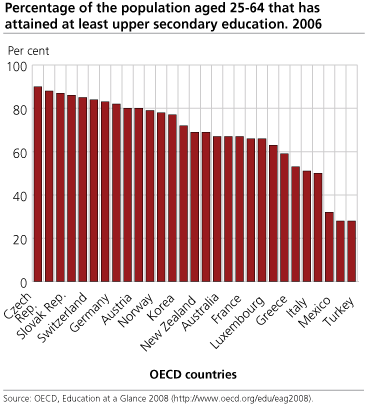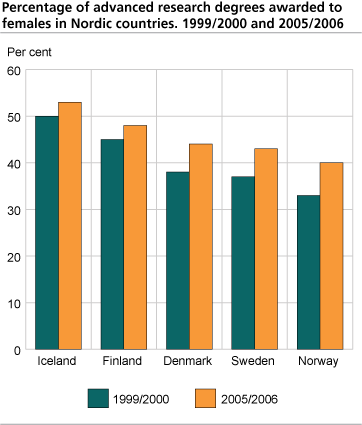Indicators on education in the OECD, academic year 2005/2006
Norway rates tenth in educational attainment
Published:
Eight out of ten in Norway aged 25 to 64 years had at least completed an upper secondary education in 2006 – ten OECD countries were rated higher. Six OECD countries had higher proportions of people with tertiary education than Norway.
- Series archive
- Indicators on education in the OECD
The OECD publication Education at a Glance 2008 , which is published today, shows that several OECD member countries have a higher educational attainment than Norway. In Norway, 79 per cent of the population aged 25 to 64 years had at least upper secondary education. All Nordic countries but Iceland had higher proportions of people with at least upper secondary education.
One-third of those aged 25 to 64 years in Norway had a tertiary education in 2006. Six OECD countries had higher proportions. Canada and Japan had the largest proportions with a tertiary education, 47 and 40 per cent respectively.

Females are closing the gap in earning doctorates
For all OECD countries but three, the female proportion of those awarded advanced research degrees has increased since 2000. Average female proportion for all OECD countries was 39 per cent in 2000. In 2006, more than 43 per cent of awarded doctorates were women. Portugal and Iceland have the largest female proportions among awarded doctorates, 60 and 53 per cent respectively.
The female proportion has increased by 7 percentage points from 2000 till 2006, from 33 per cent to 40 percent. All Nordic countries have higher proportions of females awarded advanced research degrees in 2006 than in previous years. According to statistics from NIFU STEP on doctorate degrees in Norway , the female proportion on earned doctorate degrees will increase in 2007.

3 out of 10 aged 20 to 29 years in education
30 per cent of people aged 20 to 29 years in Norway were enrolled in education in 2006. The country mean in OECD countries was 25 per cent for this age group. All other Nordic countries, and also Australia, Greece and Poland, had higher proportions in education among 20 to 29 year olds.
In the age group from 5 to 14 years the enrolment rates are close to 100 per cent for all OECD countries, with the exception of Turkey. For 15 to 19 year olds the enrolment patterns vary across OECD. In Belgium, Greece and Poland more than 90 per cent were enrolled. In Norway and 18 other OECD countries more than 80 per cent of all 15 to 19 year olds were enrolled in education. Less than 50 per cent were enrolled in Turkey and Mexico.
Tables
Table 2 Population aged 15-19 and 20-29 in education. Per cent. 1995-2006
Contact
-
Statistics Norway's Information Centre
